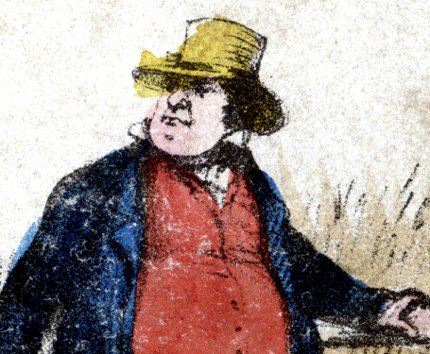Chromolithography
Colour lithography was invented in 1798 by a Bavarian actor and playwright named Alois Senefelder (1771-1834). It is based on the principle that oil and water do not mix.

Right: mid-nineteenth century children's playing card in which the black outline drawing has been printed by lithography and the coloured areas applied by hand with a paint brush, c.1850 see more →
Printing of Playing Cards :: Chromolithography
It is based on the principle that oil and water do not mix. The process involves the artist drawing the design directly onto a highly polished lithographic stone (carboniferous limestone) using a greasy, acid resistant pigment. When the stone is then placed in a weak acid the uncoloured areas are etched by the acid, leaving the painted areas intact and ready to be used as a printing surface. For multi-colour printing, several stones would be prepared, one for each colour. Gradations of colour were achieved by applying hundreds of tiny dots of each colour on their respective stones, so that when each stone was printed onto the paper the resultant area would be printed with multiple dots of different colours which to the human eye would appear realistic. But if a magnifying glass is used to examine the printed areas, the presence of irregular, multicoloured dots will indicate that the card was printed by the chromolithographic method. Furhermore there will be no “ink squeeze” as with letterpress printing.
Above: 'Historic' playing card printed by chromolithography, Goodall & Son, London, c.1897, showing the irregular, multicoloured dots which indicate that the card was printed by the chromolithographic method see more →
This process, known as chromolithography, was one of the more popular methods of printing playing cards during the 19th century and at its height produced very high quality colour prints. It continued to be used until the late 1930s to produce inexpensive, “cheap and cheerful” colour images and zinc sheets eventually replaced the heavier and more expensive limestones. The B. Dondorf factory in Germany was especially famous for its beautiful chromolithography playing cards, and Spanish, French, Belgian, Swiss, British and American firms also used this process for playing card production.

Above: chromolithographed advertising playing cards for Chocolates "El Barco" designed by E. Pastor and manufactured by Simeon Durá, Valencia, Spain, c.1895. See more →

Above: close view of a limestone lithographic stone from the Turnhout Playing Card Museum showing four cards of the Genoese pattern (in reverse) alongside fully printed cards by Brepols (top) and Mesmaekers (below), c.1920s.
See also: Printing Presses from the Turnhout Playing Card Museum Amos Whitney's Factory Inventory Letterpress Printing Manufacture of Cardboard Manufacture of Playing Cards, 1825 Queen Victoria Diamond Jubilee, 1897 The Art of Stencilling.
Further reading: https://en.wikipedia.org/wiki/Chromolithography►

By Simon Wintle
Member since February 01, 1996
Founder and editor of the World of Playing Cards since 1996. He is a former committee member of the IPCS and was graphics editor of The Playing-Card journal for many years. He has lived at various times in Chile, England and Wales and is currently living in Extremadura, Spain. Simon's first limited edition pack of playing cards was a replica of a seventeenth century traditional English pack, which he produced from woodblocks and stencils.
Leave a Reply
Your Name
Just nowRelated Articles

Historical Characters
Double-ended deck with historical characters and jacks as jesters by Daveluy, c.1850.

Printing Presses
Antique printing presses from the Turnhout Playing Card Museum collection.

Lo Stampatore
‘Lo Stampatore’ linocut images created by Sergio Favret, published as a deck of cards by Editions So...

Lorilleux International
Promotional pack for Lorilleux International’s Lotus inks, with designs by James Hodges.

Imperial Club playing cards
Large index broad size cards by AGMüller using a special red ink suitable for casinos.

Lithographic Stone
Historic lithographic stone from the Fournier playing card factory, c.1888.

H.P. Doebele
Artist-designed playing cards produced to demonstrate the quality of a printing technique.

Luxury Collectable Playing Cards
Luxury packs of cards have been produced since the 15th century, a trend that is very popular among ...

Geschichte des Buchgewerbes
Geschichte des Buchgewerbes illustrated by Ludwig Winkler, published by Verlag für Lehrmittel Pößnec...

Master of the Playing Cards
Animal suited playing cards engraved by the Master of the Playing Cards, Germany, c.1455

Goodall’s “Historic” Playing Cards
Goodall’s “Historic” Playing Cards depict royal costumes of four periods in English history, 1893.

Lilian Cailleaud’s Tarot Project
Lilian Caillaeud lino-cuts his version of the tarot by Nicolas Rolichon of Lyon c.1600

La Suisse Historique Swiss Cantons souvenir
A masterpiece in the genre of tourist souvenir decks, “La Suisse Historique” Swiss Cantons souvenir ...

Fleet Street
“Fleet Street” card game published by Chad Valley Games, c.1923.

41: A Guide to Dating Playing Cards
Dating is a particularly tricky but very interesting problem to tackle and there are many pitfalls. ...

Carte per Signora
“Carte per Signora” patience pack was produced by Fratelli Armanino, Genova, in c.1897.
Trending Articles
Popular articles from the past 28 days



 Your comment here. Your comment here. Your comment here. Your comment here. Your comment here. Your comment here. Your comment here. Your comment here. Your comment here. Your comment here. Your comment here. Your comment here. Your comment here. Your comment here. Your comment here. Your comment here. Your comment here. Your comment here. Your comment here. Your comment here. Your comment here. Your comment here. Your comment here. Your comment here. Your comment here. Your comment here. Your comment here. Your comment here. Your comment here. Your comment here. Your comment here. Your comment here.
Your comment here. Your comment here. Your comment here. Your comment here. Your comment here. Your comment here. Your comment here. Your comment here. Your comment here. Your comment here. Your comment here. Your comment here. Your comment here. Your comment here. Your comment here. Your comment here. Your comment here. Your comment here. Your comment here. Your comment here. Your comment here. Your comment here. Your comment here. Your comment here. Your comment here. Your comment here. Your comment here. Your comment here. Your comment here. Your comment here. Your comment here. Your comment here.